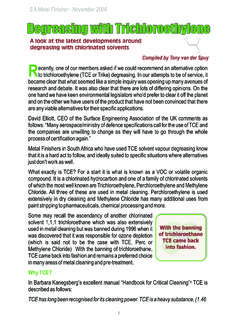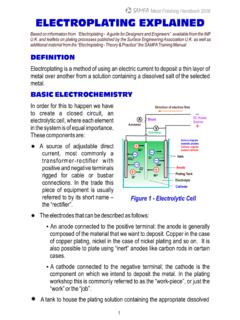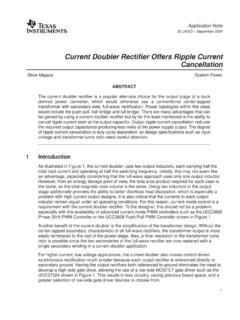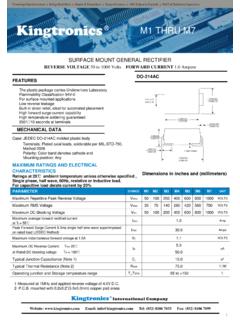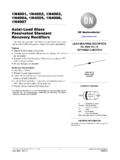Transcription of PLATING RECTIFIERS - SAMFA
1 Today s rectifier operates on the same principles used for decades. Sure,there have been many incremental improvements in manufacturing methodsand materials, but the basic principles are the same. The most noteworthyimprovements are those associated with electronics and computerisation. Allrectifiers have 1) a transformer that lowers Eskom s high voltage to the 6 18volts normally used by electroplaters or to the somewhat higher voltagesrequired by anodisers; 2) a rectification system that changes alternatingcurrent (AC) to direct current (DC); 3) power regulators; 4) controls and 5) ameans of cooling these components. Other than the cooling section, there areno moving transformer has primary and secondary sets of magnetic cores wound withconductive wire. The ratio of the number of wire turns around the primaryversus the number around the secondary regulates how much the voltage isstepped down.
2 For example, if the primary has 400 turns and the secondary10 turns, the ratio is 40:1. Therefore if the input to the primary is 400 v, thesecondary s output is 10 v (400/40). Most common PLATING processesrequire 6-18 v, and RECTIFIERS producing this at amperages of 50 - 10,000 ormore produces a wave on an oscilloscope that oscillates above and below thehorizontal. The rectifier filters out the lower portion of the wave, as shown inFig. 1a. This is half-wave rectification. It pulsates. Fig. 1b shows full-wave,single-phase rectification, which still has pulsation, but at closer 1c shows full-wave, three-phase rectification. It still has slight pulsation,but there is a variation (ripple) of less than 5%, and that is satisfactory formost (notall)electroplating modern rectifier uses a semiconductor (usually silicon) to filter out theTransformersRectification and ControlReprinted with the permission of Products Finishing Magazine.
3 2010 Gardner Publications, RECTIFIERS1S A Metal Finisher November 2010AC and allow only DC to flowthrough it. The simplest of thesedevices is known as a diode. Silicon also can be part of control-ling a rectifier . These devices areknown as thyristors or silicon-controlled RECTIFIERS (SCR). Theyare basically diodes, but require acontrol signal at a terminal or gate. They are used both forrectification and regulation ofoutput, depending on the difference is in whether theSCR is used on the primary or secondary side of the transformer. There aregood reasons for either design, based upon your applications, the unit sefficiency, reliability and cost. Your rectifier supplier should consider yourneeds and explainwhich willworkbetter foryouand problem with SCRs is that they produce DC distorted by ripple - theremainder of the fluctuating AC sine wave.
4 Most larger RECTIFIERS produceripple of five percent or less at rated capacity. Operating a rectifier at far lessthan its capacity is not a good idea, since ripple increases as the unit ispowered down. PLATING chromium, precious metals, alloys and certain othermetals requires minimum ripple, and if ripple is too high, it s easy to add aripple filter that smoothes the wave. Ripple is not very important inelectrocleaning, electropolishing and tap switch is a simple alternative to solid-state controls. It relies onswitching between varying numbers of wire windings on the primary andsecondary transformer sections. If, for example, one has 400 windings on theprimary and 10 on the secondary, with an output of 12 v, voltage will be cut tosix if the windings on the primary are doubled to 800. A switch contactinglarger or smaller numbers of windings on the primary controls the voltage.
5 Atap-switch control produces DC with less than five percent ripple regardlessRippleOther Control MethodsOne CycleOne CycleOne CycleABCF igure 1 Mean DC VoltsMean DC VoltsMean DC Volts2S A Metal Finisher November 2010of the output voltage. A disadvantage, however, is that voltage fluctuationsare normal, a problem if PLATING thickness is critical. A similar control is thevariable autotransformer, which works on the same principle, but has no taps, and iscontinuously type of rectifier is the switching transistor-type. An EMI filter rectifiesand filters incoming line power to produce DC. An inverter changes it back toAC at approximately 1,000 times the line frequency. This high-frequency ACis then stepped down to PLATING voltages, and rectified and filtered again toproduce a high-current, low-voltage output, with very low ripple.
6 Platingvoltages and amperages come from a totally sealed, water-cooled small footprint and light weight allow it to hang on a wall or fit whereconventional units won most striking technology changes have been those made possible byelectronic components microprocessors, computers, etc. RECTIFIERS withdigital controls regulate amperage and voltage more precisely. They allow thecurrent to be ramped up as the parts enter PLATING or anodising tanks, andturned off at precisely the right times. They can provide pulse PLATING , controlampere-hours, reverse current, and be programmed for complex waveforms. They may have computer interfaces. computerisation (some of itfrom personal computers equipped with special software) and microproces-sors can control a number of RECTIFIERS , the movements of hoists and convey-ors, additions of brighteners and other chemicals, solution temperatures,agitation and other variables.
7 You can apply exactly the thicknesses of metalsspecified, in the sequence desired, time after time. computerisation tells theoperator at a remote location when something isn t right. That cuts costs,reduces rejects, produces a part that is the same every time, and eliminateslabour. The computer can control power so exactly that none is wasted, thuscutting power bills. Its memory records what has been done to each part andunder what conditions. Ifthere is areject, it seasiertotracewhat use RECTIFIERS very similar to those used by electroplaters, exceptSwitch-Mode PowerComputerisationAnodising3S A Metal Finisher November 2010that higher voltages are required as high as 150v for hard-coat color-anodising processes such as electrolytic colouring require ACpower supplies (still referred to as RECTIFIERS ) as well as DC and instrumen-tation that allow adjusting voltages and positive-negative cycles rapidly andaccording toapredetermined PLATING involves application of rapidly cycled interrupted direct may be combined with periodic reverse, in which the current is cycledbetween forward and reverse, for preset times in each direction.
8 In electron-ics applications pulse PLATING produces deposits that are denser, have finercrystal structure, can be applied more rapidly, are smoother, and require lessplating-solution additives. RECTIFIERS for these applications are programma-ble for a range of currents measured in milliamps to perhaps 1,000 amperes,delivered as forward, reverse or pulsed current, or combinations are more expensive, but so is gold. Pulse PLATING and interrupted-current techniques have moved beyond the electronics industry to suchapplications as electropolishing, anodising, electrocleaning and rectifier should be as close as possible to the PLATING tank. The fartheraway, the longer the bus runs and the greater the current losses and mainte-nance. The problem is that you have to cool the rectifier components toprolong their life, and if the rectifier is air cooled, it may be drawing in corro-sives, shortening its life.
9 Sometimes the problem can be solved by installingthe rectifier on the other side of a nearby wall. The controls can still be next tothe PLATING station. But if that s not feasible, there are air-tight water- cooledunits, either direct or heat-exchange. RECTIFIERS are rated to be operated atcertain maximum temperatures, and if the ambient air exceeds thosetemperatures, water coolingmaybe have no moving parts other than the fans or pumps used forcooling. Properly installed and operating at prescribed temperatures, theyshould last for a long time. As with any other piece of equipment, regularPulse PLATING and Periodic ReverseRectifier PlacementMaintenance and Repair4S A Metal Finisher November 2010maintenance pays. Change or clean air filters regularly and keep away boxesor other items that interfere with air flow. Be sure that fan blades are water pumps and filters.
10 Keep semiconductors and heat sinks cleanto aid in cooling. Check all the control instrumentation - buttons and lights,etc. - regularly,and replaceif often have onboard diagnostics that show trouble spots on theirdigital displays. Ammeters, voltmeters and oscilloscopes help to isolatetroubles. You don t have to be an electrical engineer to repair a rectifier , but youdo have to understand electrical equipment and be aware of the dangers ofhigh voltages and currents. Suppliers of RECTIFIERS provide detailed manualsand partsliststo aid in repairing and minimising know some of the things you like about the RECTIFIERS you have now. Yourchemical supplier may suggest features that would improve the processesused in your shop. Hopefully this brief article triggers thinking about otherideas you d like to explore. What makes a good rectifier ? What should youlook for when considering a purchase?
